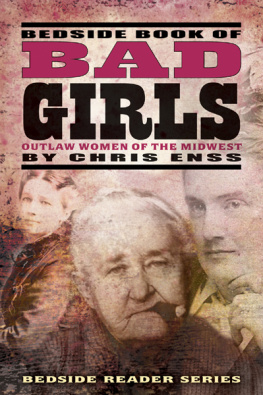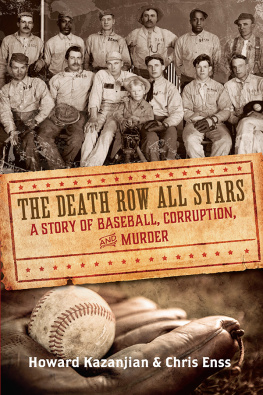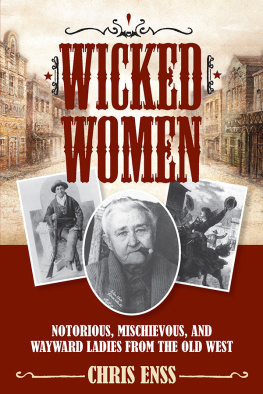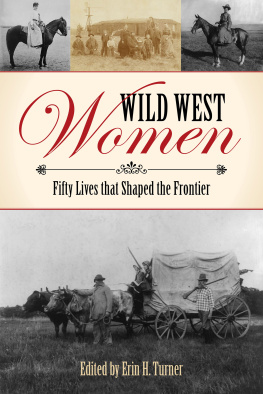Entertaining Women
A TWODOT BOOK
An imprint and registered trademark of Rowman & Littlefield
Distributed by NATIONAL BOOK NETWORK
Copyright 2016 by Chris Enss
All rights reserved. No part of this book may be reproduced in any form or by any electronic or mechanical means, including information storage and retrieval systems, without written permission from the publisher, except by a reviewer who may quote passages in a review.
British Library Cataloguing-in-Publication Information available
Library of Congress Cataloging-in-Publication Data available
ISBN 978-1-4422-4733-8 (paperback)
ISBN 978-1-4422-4734-5 (e-book)
 The paper used in this publication meets the minimum requirements of American National Standard for Information SciencesPermanence of Paper for Printed Library Materials, ANSI/NISO Z39.48-1992.
The paper used in this publication meets the minimum requirements of American National Standard for Information SciencesPermanence of Paper for Printed Library Materials, ANSI/NISO Z39.48-1992.
Acknowledgments
T here are many people who helped in assembling material for this book, and I am indebted to them for their assistance. I wish to acknowledge with gratitude the fine staff at the California State Library for helping to gather information on many of the talented entertainers contained in this publication; the knowledge and indulgent personnel at the Searls Library, the Doris Foley Library, and the Nevada County Historical Library; Mrs. Lee Cox at the San Francisco Performing Arts Library and Museum; the staff at the Indiana State Museum and the Allen County Public Library; the staff at the Rare Book and Manuscript Library at the University of Pennsylvania; the staff at the New York Public Library; Erin Chase at the Huntington Library; and Scott Gibson at Caxton Press.
A special thank you goes to talented Editorial Director Erin Turner, Digital and Social Media Marketing Manager Sarah Baker Givens, and Publicity Manager Sharon Kunz. Without their hard work and dedication this book would be little more than an idea.
Introduction
I n 1847 the western territory of the United States was a sleepy wilderness populated mostly by Indians and Mexicans. But when word reached the eastern states that there were rich deposits of gold in the mountains of the frontier, the region changed virtually overnight. Two hundred thousand restless souls, mostly men, but some women and children, traveled to the untamed western lands, primarily to California, during the first three years of the Gold Rush. They came from all over the world, leaving homes and families for the dream of finding riches.
Soon the West was dotted with mining boomtowns and bustling new cities. Fortunes were made and lost daily. Lawlessness was commonplace. At first, gold seekers were content with the crude entertainment provided by ragtag bands and their own amateur fiddle-playing neighbors. They flocked to bear-wrestling and prize-fighting exhibitions. In this impetuous atmosphere, gambling dens, saloons, brothels, and dance halls thrived, but after a while the miners and merchants began to long for more polished amusements.
Theaters, backstreet halls, tents, palladiums, auditoriums, and jewel-box-size playhouses went up quickly and stayed busy, their thin walls resounding with operas, arias, verses from Shakespeare, and minstrel tunes.
The western pioneers passion for diversion lured brave actors, dancers, singers, and daredevils west. Entertainers endured the same primitive conditions as other newcomers. They lived in tents and deserted ship and canvas houses or paid enormous rents for the few available wooden cabins. But nineteenth-century thespians were often prepared for such a lifestyle. Acting was largely an itinerant profession at the time, and most players earned their living barnstorming from town to town, and even from country to country, performing different plays or musical numbers from a large repertoire every night of the week. Bored miners were willing to pay high sums to these entertainers, especially to the females.
Many of the most popular women entertainers of the mid- and late 1800s performed in the boomtowns that dotted the West, drawn by the same desire for riches and bringing a variety of talents and programs. They were mostly well received and sometimes literally showered with gold, but their personal lives were often marked by tragedy and unhappiness. Within the chapters of this book are the stories of a few of these gifted thespians who brought glitz, glamour, and genius to western America. The footlights have been illuminated, and the curtain is about to go up, revealing the tales of women entertainers who captured the hearts of the western pioneers.
Catherine Norton Sinclair The Talented Divorcee
You know as well as I do that the cause for my leaving you was the conviction of your infidelity.
EDWIN FORREST TO HIS WIFE, ACTRESS CATHERINE NORTON SINCLAIR FORREST SHORTLY AFTER HE DISCOVERED LOVE LETTERS SHE HAD WRITTEN TO ANOTHER MAN.
S hakespearean actor Edwin Forrest rifled through the desk drawer in the sitting room of the New York home he shared with his wife, socialite-turned-actress-and-theater-manager Catherine Norton Sinclair. The contents of the drawer belonged to Catherine, but Edwin wasnt interested in maintaining her privacy. In his frantic search he uncovered a worn and rumpled letter written to his bride from fellow thespian George Jamieson. And now, sweetest, our brief dream is over; and such a dream! the correspondence began. Have we not known real bliss? Have we not realized what poets have to set up as an ideal state, giving full license to their imagination, scarcely believing in its reality? Have we not experienced the truth that ecstasy is not fiction? And oh, what an additional delight to think, no, to know, that I have made some happy hours with you... With these considerations, dearest, our separation, though painful will not be unendurable; I am happy, and with you to remember and the blissful anticipation of seeing you again, shall remain so... Jamiesons declaration of his feelings for Catherine ended with a promise to do my utmost to be worthy of your love.
Edwin reread the letter with poised dignity, and on its completion he sank into the nearest chair, cursing the day he had met the woman he had married. After a few moments he arose and frantically paced about the room. He denounced Catherine for her infidelity and fell to the floor weeping uncontrollably. According to Edwins biographer, William Rounseville Alger, Edwin was struck to the heart with surprise, grief, and rage. Catherines take on Edwins reaction and the circumstances surrounding her husband reading the letter are vastly different from Algers account. Almost from the moment the pair met, Edwin was jealous of everyone Catherine knew in her social standing and did not shy away from making a scene.
Catherine was born near London in 1818 to Scottish parents who had four children in all. Her father, John Sinclair, was a well-known vocalist who had toured America in 1831 and 1833. Historical records note that Catherine was endowed with natural beauty, and, whatever the quality and quantity of her formal and social education, she had in her teens acquired a sparkle and vivacity that attracted men. She was popular and well liked and attended formal soirees, theatre openings, and art exhibits with myriad friends from all walks of life.
In October 1836, Catherine and a gathering of women, who formed the social circle to which she belonged, attended a performance of a play called The Gladiator. The star of the show was Edwin Forrest. His talent on stage was exceptional, and he was quite aware of the genius he possessed. He relished the positive attention he received from critics and followers. He enjoyed giving spontaneous soliloquies to young women who approached him after a performance. When speaking in or about plays, particularly those of Shakespeare, Edwin exuded confidence. Off stage, however, he struggled to find his place. He was an uneducated man and self-conscious about his impoverished background and lack of refinement.








 The paper used in this publication meets the minimum requirements of American National Standard for Information SciencesPermanence of Paper for Printed Library Materials, ANSI/NISO Z39.48-1992.
The paper used in this publication meets the minimum requirements of American National Standard for Information SciencesPermanence of Paper for Printed Library Materials, ANSI/NISO Z39.48-1992.